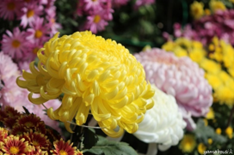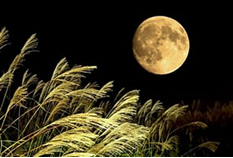September 9th Chrysanthemum Festival and September 10th Mid-Autumn Moon
Yoshie Doi
 |
 |
September 9th is said to be an auspicious day when the number 9 overlaps. In China, it is called ‘Chou-kyu:Chóng jiǔ’ because the yang numbers (odd numbers) overlap, and it is considered to be a very auspicious and festive day.
At Kamigamo Shrine, the Choyo Shinji and crow sumo wrestling are held, and at Horinji Temple in Arashiyama, the Choyo no Sechie is held.
Like the Peach Festival (March 3rd) and Tango no Sekku (May 5th), the Chrysanthemum Festival did not take root in Japan today. It is said that in the Edo period, this festival was later used as the Doll’s Festival, and the flowers that were displayed in March were displayed again on September 9th, the Chrysanthemum Festival, to pray for longevity.
Chrysanthemums bloom in the ninth month of the lunar calendar, and chrysanthemum banquets (Chrysanthemum banquets) were held in the court, where people drank chrysanthemum wine and recited poetry to celebrate their longevity. In ancient China, it is said that Kikujido drank the dew of chrysanthemum flowers and lived to be 700 years old.
It is said that Gosekku was started in the early Edo period by the Ichijo family, who quoted from a Chinese story.
In the Edo period, five seasonal festivals (January 7th (Jinjitsu), March 3rd (Jiyoshi/Peach Festival), May 5th (Tango/Shobu no Sekku), July 7th The Chrysanthemum Festival was held as the most official event on September 9th (Shichiseki/Tanabata) and the Chrysanthemum Festival (Chrysanthemum Festival). People soaked the rice and drank sake, and the common people cooked millet rice to ward off evil spirits and wish for long life.
This event, which was introduced in the early Heian period, was abolished by the government in the early Meiji period.
The festivals in March, May and July are loved by the common people and are still held today. The custom of eating Nanakusa porridge on January 7th has been passed down to the present day.
The harvest moon in 2022 is September 10th. It is said that the custom of admiring the Mid-Autumn Moon was introduced from China during the Heian period.
It is also called the sweet potato moon because the sweet potatoes were offered on the night of the full moon.
It is widely known that Tsukimi dumplings are offered, but originally taro was offered. There is even a record in the court that says, “In celebration of the full moon, three sides (treasures) are filled with taro or sweet potatoes.’
‘ How about admiring the harvest moon while making a wish during this year’s mid-autumn harvest moon?
The end of document
